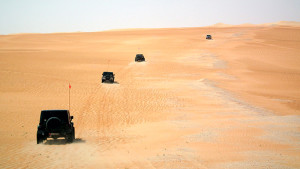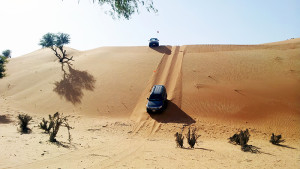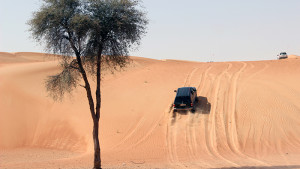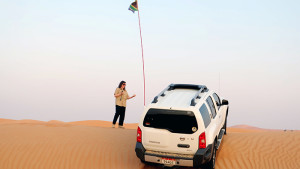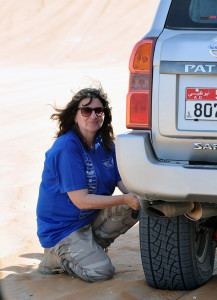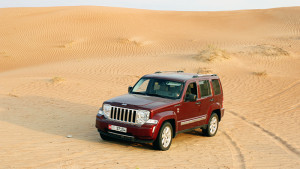One of the best things about living in the UAE is the ease of access to the outdoors. Some may choose to bike, climb or paddle to discover new places but for a self-confessed petrol head like me there is only one way to explore, and that’s using four wheels!
Perfect convoy driving by Debra Galvin
Desert driving
The first time I sat behind the wheel in the desert I thought, “I regularly drive on snow and ice, how difficult can sand driving be?” I discovered in the next few hours, in fact over the next few years, that there is far more to it than you would imagine!
You need to think about so many things that your brain goes into overdrive and after your first two hour drive you will probably want to go home and sleep for hours! For instance, you need to look where you are going, watch your speed, keep an eye on your rev counter, listen to your engine, keep enough distance between you and the car in front…and that is just when you are travelling over flat sand!
There are certain similarities to snow driving in that moderation of power is extremely important – too much and your car will be out of control which is never a good thing; too little and you are likely to get stuck, although at least if you get stuck in sand you won’t get frostbite!
Controlled descents are essential for keeping bumpers attached
Wadi driving
There are many wadis (dried up riverbeds) to be explored in the Northern Emirate, and even more in Oman (see my article on Wadi Aydam in last month’s OutdoorUAE); many people choose wadis where they can camp/swim/climb and make a weekend of it. The driving skills required here are completely different to those employed when desert driving; whereas in the desert power is
everything, wadi driving and rock crawling need a somewhat gentler approach to steer through the rocks and ledges you will typically encounter.
Climbing is fun
The difference between 4x4s and AWD/4WD
All Wheel Drive cars generally have permanently engaged 4WD; power is delivered to each wheel via a computer, ensuring good road holding. The computer decides which wheel to channel the power to and this takes a split second. In sand, often this tiny delay means you can find yourself stuck! Many experts are of the opinion that prolonged sand driving can put immense strain on the vehicle’s drive train, possibly leaving you with a broken down car at the edge of the desert and a hefty repair bill to follow. However, that is not to say that a well maintained AWD cannot take you into the desert on a camping trip, especially if you know what you are doing and take care.
4x4s are usually often more expensive, but with an experienced driver behind the wheel should be able to traverse a variety of extreme terrain. Most have part-time 4 wheel drive which means that 2WD, normally to the rear wheels, is used for road driving, cutting down on fuel and tyre costs. When you hit the sand or the rocks, switch it into 4WD and a series of differentials will deliver equal power to each wheel. There are times when maximum power and control are required – a 4LOW function changes the gear ratios to assist out of the trickiest of situations. Remember though that most 4×4 cars have a maximum speed of 45kph when this is selected – so you will need to change back to 4HIGH for more moderate terrain.
Learning when to stop by Dennis Templeton
Acquiring off-road driving skills
I picked up my elementary off-roading skills as a member of a couple of great off-road clubs, and once I thought was reasonably competent I started my own one, Oasis Offroad, to pass on the lessons I had learned. Instructional styles vary from club to club and Oasis Offroad starts rookies off with an “Easy Introduction to Offroading” whereas many others adopt a “follow me and you will soon pick it up” style. Do some research before signing up to a club to make sure you choose one that suits you.
Over the years I have seen many drivers capable of advanced manoeuvres who lack some fundamental skills, and I am a great believer in learning to walk before you can run. I like to coach new and improving drivers in soft skills while they hone their practical ones; things like recognising when to check and deflate your tyres some more (after half an hour on a hot day as pressures may have risen, or if the going becomes much softer) or understanding some basic causes of overheating cars in the summer (leaving the a/c on when climbing dunes, too many people in the car or carrying too much stuff).
I cannot condense what I have learned in 20,000kms of sand driving over 500 trips into one article, but here are some
top tips for you.
Deflating tyres to correct pressure is important by Donald Matheson
Before you select 4×4, prepare your car
Deflate your tyres
It’s a good idea to start at 15psi as you are unlikely to unseat your tyre from the rim at this pressure. Later you can gradually deflate them to the optimum pressure for your car, your driving style and the prevailing sand conditions; I deflate mine to 12.5psi, front and rear.
Check that everything is secure
Use a cargo net or boxes with bungee cords to keep everything in place should your car go for a short flight! (Whenever the car is moving make sure you wear your seatbelt too)
Consider fixing an offroading flag to the rear of your car
This makes the drive much safer as those following you will see where you are if you cross a small dune.
Turn off your traction control, should you have it as it can work against you in the desert.
My Patrol Safari does not have this but I do disable the ABS when off-roading and some vehicles are best with their airbags disabled when off-roading.
Even low cars can tackle some terrain
Driving on flat terrain
Choose your gear
Highish revs are your friend when off-roading so I suggest that you limit your automatic gear to 3. If you are lucky enough to have a manual car then you will find yourself using gears 1 and 2 most, with occasional 3rd gear when on easy terrain.
Watch where you stop
Starting off from soft flat sand can be very tricky. Instead try to park on a slight downslope thus enlisting the help of gravity when you move off.
To reduce situations with multiple stuck cars, always keep a good distance from the car in front as that way you can choose where you stop (see above.)
Be vigilant and concentrate on where you are going at all times
Keep your eyes open for rocks, burrows and hidden small steps, all of which may cause damage to your car.
Driving over dunes
The only way to learn just how much power to apply when driving up dunes is to practise – too much and you will fly over the top and may even damage your vehicle, too little and you will not make it all the way up, or may get crested.
When driving down a dune always keep your wheels straight and the weight of the engine will assist you in reaching the bowl at the foot.
Never ever slam on your brakes – you risk your front wheels digging into the sand and your car somersaulting!
And finally the most important rule of all: never ever go on your own – even experienced drivers get stuck sometimes!
Words + Photos by: Marina Bruce
Marina is running some half-day off-road coaching sessions in October and November, just outside Al Ain. The 4-hour program will include both theory and a practical session; an extensive safety briefing; coaching on the most common obstacles such as crests, climbs and bowls; followed by a short scenic drive to bring it all together. Groups will be small – a maximum of 4 vehicles per practical session; separate sessions will be run for low or long cars and these will also be suitable for AWD and 4WD cars – find out what your Kia Sedona, Ford Explorer or Hyundai Tucson can do! To find out more please email marina@desertdivaevents.com.

